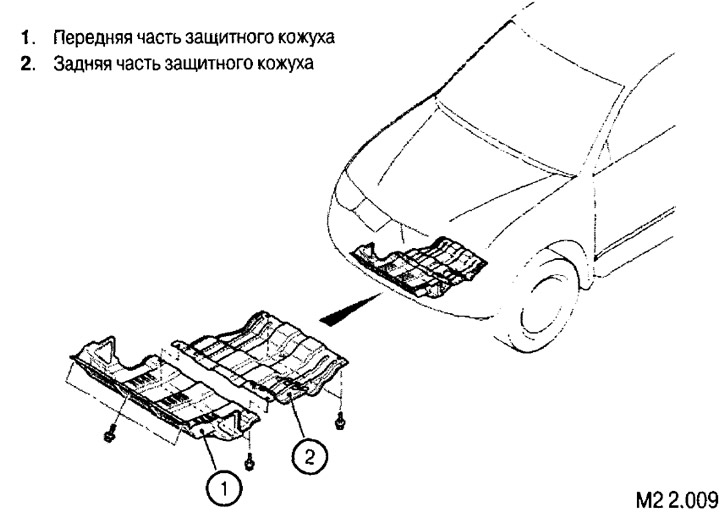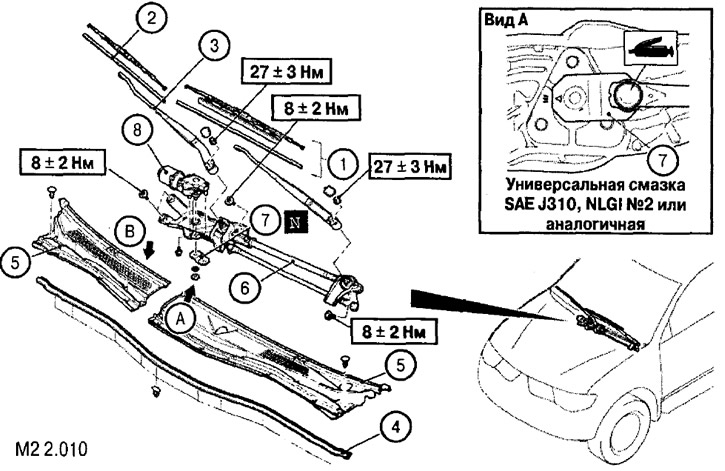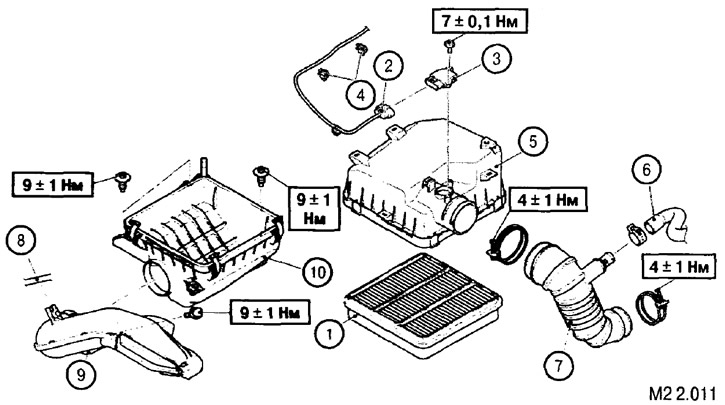Preliminary Operations
1. Remove the front and rear of the lower engine compartment guard (see fig. M2 2.009).

2. Remove the hood.
3. Remove the wiper mechanism assembly (see fig. M2 2.010).

Removing the wiper mechanism: 1. Wiper blade assembly; 2. Rubber brush element; 3. Wiper arm; 4. Hood seal; 5. Overlays; 6. Drive mechanism; 7. Mounting plate; 8. Electric drive
* Removal of elements is carried out in the order of the numbers indicated in the figure
4. Disconnect and remove the battery.
5. Remove the air filter elements (see fig. M2 2.011).

Removing the air filter elements: 1. Filter element; 2. Air flow meter connector; 3. Air flow meter; 4. Harness clamp; 5. Air filter cover; 6. Breather hose; 7. Air outlet; 8. Radiator expansion tank hose; 9. Air duct; 10. Air filter housing
* Removal of elements is carried out in the order of the numbers indicated in the figure
6. Drain coolant and engine oil.
7. Disconnect and remove elements of the cooling system (pipes, expansion tank, radiator, air conditioner condenser, etc.) (see fig. M2 2.012).

Removing elements of the cooling system: 1. Drain plug; 2. O-ring; 3. Radiator plug; 4. Top nozzle; 5. Lower branch pipe; 6. Oil cooler supply hose (automatic transmission); 7. Oil cooler supply pipe (automatic transmission); 8. Oil cooler return (automatic transmission); 9. Oil cooler return pipe (automatic transmission); 10. Supply hose clamp (automatic transmission); 11. Expansion tank hose; 12. Lower fan cover; 13. Cooling fan shroud; 14. Radiator; 15. Lower radiator support; 16. Expansion tank; 17. Bottom panel (airflow guide)
* The elements are removed in the order of the numbers indicated in the figure.
8. Remove the elements of the radiator cooling fan (see fig. M2 2.013).

Removing drive belts and fan: 1. Bottom fan shroud; 2. A/C compressor drive belt; 3. Generator drive belt and power steering pump; 4. Impeller and fan clutch assembly; 5. Coolant pump pulley; 6. Fan impeller; 7. Fan clutch
* Removal of elements is carried out in the order of the numbers indicated in the figure
9. Next, disconnect and remove the elements indicated in the figure (see fig. M2 2.014).

1. Engine cover; 2. Connection terminal with «weight»; 3. Control unit wiring harness; 4. Battery harness; 5. Steering oil pump assembly; 6. Air conditioning compressor assembly; 7. Branch pipe of the vacuum brake booster; 8. Branch pipe of the sensor of the vacuum brake booster; 9. Vacuum hose of the electrovalve of shutdown of a drive of forward wheels; 10. Fuel supply hose; 11. Fuel return hose; 12. Screw for fastening the front engine mount; 13. Engine assembly
* Removal of elements is carried out in the order of the numbers indicated in the figure
Note: Power steering pump (5) and air conditioning compressor (6) removed as an assembly without disconnecting the corresponding lines. After removal from the engine, they must be hung and secured in the engine compartment so that they do not interfere with the removal and subsequent installation of the engine assembly. Note: after disconnecting the fuel return line (11) and before removing the screws securing the front supports (12) it is necessary to perform work on disconnecting and removing elements of the exhaust system and USR and elements of fastening and transmission control (cardan shaft, clutch drive, manual transmission, controls and automatic transmission oil cooling). Description of these works is given in the relevant sections of this book.
It is also necessary to jack up the engine from below.
10. Disconnect the power unit from the supports.
11. Once again carefully check that all connected elements are disconnected from the engine and nothing prevents its removal.
12. Having securely fastened the cable to the engine, using a winch (1) Carefully remove the engine assembly from the engine compartment.

Installation is carried out in the reverse order of removal, followed by all necessary checks and adjustments.

